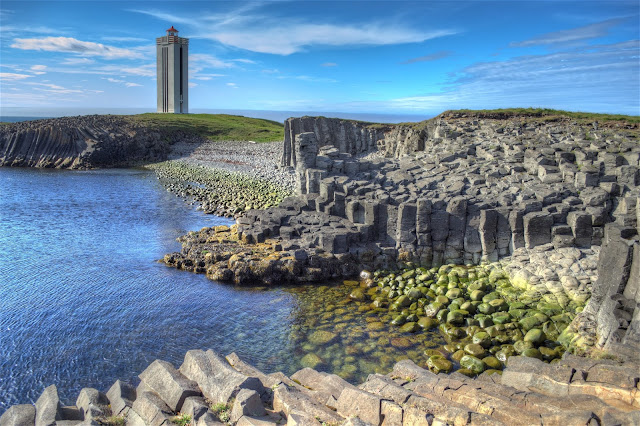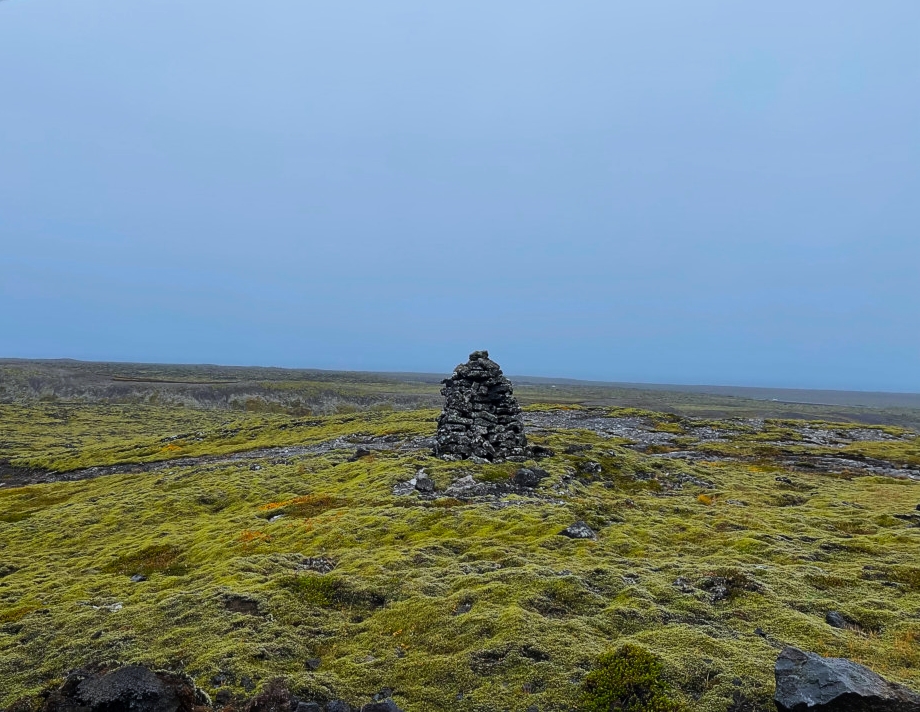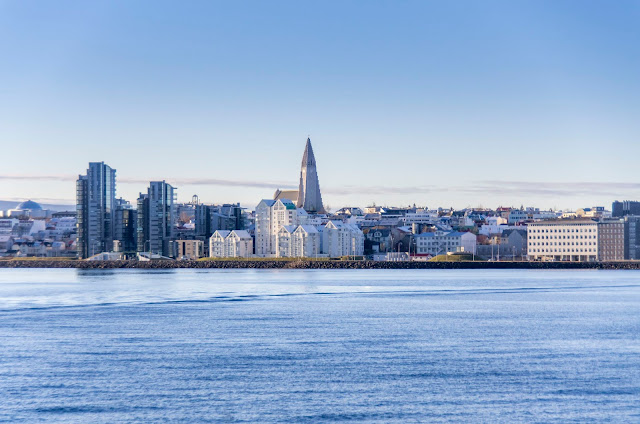Tables moved and plates broke
 |
| Kálfshamarsvík Lighthouse. Saurar farm is on the other side (north) of the lighthouse. Mariejirousek |
 |
| Map of the ocean between Greenland, Iceland and Norway. The yellow dot shows the location of Saurar. Paul Homewood |
 |
| Saurar farm. Standing in the door is farm-owner Guðmundur Einarsson and next to him is his son, Björgvin. Þórður |
 |
| A quick map of the house drawn by a reporter from memory. Among the items that kept mysteriously moving was the oval table by the window in baðstofa, the beds by the wall, the sofa-bed in the kitchen, the kitchen table and the cupboard in the kitchen that stands on the floor. Ragnar Lárusson |
Abnormal activity
 |
| The oval table between the beds in the baðstofa. If you look closely, you can see the table top has become damage from all the movements that began on March18th. |
 |
| The Saurar couple with four of their children. From left: Guðmundur Einarsson, Björgvin, Sigurborg, Margrét Benediktsdóttir, Arnfríður and Benedikt. Þórður |
 |
| Dishes broke on a few occasions. Here are some of the plates a reporter was able to get a photo of that had been carried out. MBL |
 |
| Margrét looking exhausted and confused is being interviewed by the reporter Stefán Jónsson with the newspaper Alþýðublaðið. Grétar Oddsson |
 |
| Saurar farm. The front door is on the other side of the house. MBL |
 |
| Margrét looking for something in her dresser. |
 |
| The cupboard in the kitchen. DV |
 |
| A reporter took a photo of the broken chair. Grétar Oddsson |
The ghost seekers
 |
| Sigurlaug Guðmundsdóttir, the daughter who lives on the farm. Grétar Oddsson |
 |
| Besides all the phone calls, the little farm was constantly receiving visitors wanting to experience the mystery themselves. The coffee pot was brewing nonstop. Grétar Oddsson |
 |
| Þórður Jónsson (f.1918 – d.2009). Héraðsskjalasafn Austfirðinga |
The farm caught the interest of the Icelandic Society for Psychical Research and on March 21st, several members headed out to Saurar to investigate the matter further. Among the members were the medium Hafsteinn Björnsson and its president, Sveinn Víkingur. Some of the other members were Sigurlaugur Þorkelsson, Katrín J. Smári, Helgi Vigfússon, Mildríður Falsdóttir and Sigurveig Hauksdóttir.
 |
| At the time, Rev. Sveinn Víkingur was the president for the spiritist society and Hafsteinn Björnsson its medium. Read more about Sveinn in my blog here. Read more about Hafsteinn in my blogs here. |
 |
| Ingibjörg Skarphéðinsdóttir (1916-1974) was known for her mediumsitic abilities and is a descendants of Einar from Bóla, who many consider one of Iceland’s most talented mediums. Nanna Tómasdóttir |
 |
| The clairvoyant Ævar Jóhannsson sitting at the oval table in the baðstofa. DV |
 |
| Reporters snapped a photo of the medium Hafsteinn Björnsson as he arrived at Saurar farm. DV |
 |
| Sigurlaugur Þorkelsson suspected it was poltergeist phenomenon where the tenants were unwillingly causing the movements. SG |
 |
| Ós and Saurar. The farm is in a remote location by the Nordic Sea. Mats Vibe Lund |
 |
| Ingibjörg Lára Ágústsdóttir (1899-1971) was accompanied by her husband Steingrímur Sigursteinsson (1914-1999) to Saurar. |
 |
| Saurar. A photo of what the ground looks like by the shoreline. Byggðasafn Skagfirðinga |
 |
|
Tómas Tryggvason, geologist. The first Icelander to study minerology and petrology. Unknown
|
Poltergeist
 |
| Left: Benedikt Guðmundsson (1926-1992). After the spooky incident, everyone in the family moved out, except Benedikt. He lived at the farm until his death. Towards the end of his life, he struggled with his health. One day he went missing and after a few days’ search, he was found dead by the shore in Saurar. Center: Guðmundur Einarsson (1892-1973), Björgvin Guðmundsson (1920-1995) and Margrét Benediktsdóttir (1894-1973). Björgvin didn’t live at home at the time, but came home about the same time as the events began. Right. Sigurborg Guðmundsdóttir (1941?-?) |
 |
| The quarterly bulletin, Theta. PRF |
 |
| Dr. Roll measuring the electric fields at Saurar. LÓA |
 |
| Poltergeist was the answer that checked the most boxes. EG |
 |
| Cartoon drawing of the hauntings at Saurar. Sigmund |
The evil spirit of a bull
 |
| Left: Tjörn in Skagi. Bjarney Jónsdóttir; Right: Pétur Björnsson. HAH |
 |
| Map of Kálfshamarsvík. At the very top is Saurar. Right below it is Sauravík and Tjörn. On the upper precipice is Spánska dys which translates to Spanish Grave. More on that story is written below. |
 |
| Boli. Börn og tónlist |
 |
| Þorgeirsboli. Þrándur |
 |
| The Hólanes houses burned to the ground in December 1892. HAH |
 |
| Hólanes build in 1927, replacing the Hólanes houses that burned to the ground. Knútur Valgarð Berndsen |
 |
| Þorgeirsboli. Painted by Jón Stefánsson |
In the morning when the men were heading back home, they grabbed their belongings. Júlíus took the sweater off the hook and before he was able to put it on, he completely freaked out and threw the sweater in the garbage by the shed.
 |
| Þorgeirsboli. Painting by Michael Olito |
 |
| Saurar and Kálfshamarsvík. The lighthouse can be seen on the very tip of the small peninsula. Mats Wibe Lund |
Spanish pirates
 |
| Spákonufellshöfði. A place with many hikes. It has a vast bird life and flora with educational markers on both. The grave of a Spanish sailor is underlined in yellow. The spot was chosen because of the view. Loftmyndir ehf. / Verkfræðistofan Stoð ehf |
 |
| Kálfshamarsvík and the shore in the surrounding area. Jennifer Boyer |
 |
| Cow at Saurar. Björn Bergman |
 |
| Left: Baltasar Samper; Right: Jökull Jakobsson |
Lost at sea
In July 1914 a boat sunk in the ocean by Saurar with five or six men onboard. The sail was found in Hraun which is at the tip of Skaga. The boat itself was found half sunk in Drangeyjarsund.
 |
| A man swimming in the Drangeyjarsund. Lúðvík Kristinsson |
The aftermath
 |
| The new Saurar farm, built in 1967 on the left and the old Saurar farm on the right. GFr |
 |
| Soon after the poltergeist experience, a new house was built and the old Saurar farm left desolate. When reporters visited the farm in 1983, the old farm had collapsed. GFr |
 |
| Inside the farm in 1983. GFr |
Photos of the area
 |
| Kálfshamarsvík. Jennifer Boyer |
 |
| Kálfshamarsvík. mariejirousek |
 |
| Kálfshamarsvík. mariejirousek |
 |
| Kálfshamarsvík. Wonder who’s the black sheep in this family… Jennifer Boyer |
 |
| Kálfshamarsvík. Jennifer Boyer |
 |
| Skagi area. A mountain by Saurar farm. mariejirousek |
 |
| Kálfshamarsvík has very cool basalt columns. Jennifer Boyer |





